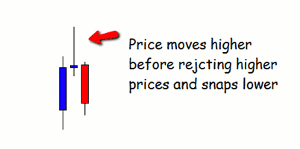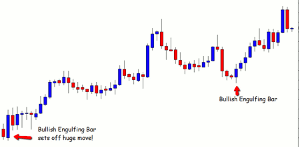Forex trader Johnathon Fox, contributor, DailyForex.com, explains the mechanics of two very simple and easy to identify price action trading signals.
Today's quick article is going to cover two very simple price action reversal signals that any trader can learn and start spotting today. These two signals are not complicated and even the newest of traders will be able to start spotting them all over their charts.
Pin Bar Reversal
I have covered in previous articles
exactly what goes into making a Pin Bar a valid signal. Basically a Pin Bar is a
candle that has a small body and a large nose that is rejecting either higher or
lower prices. The thinking behind the Pin Bar is quite simple; Price has moved
higher or lower before a wave of orders snaps price back in the other direction.
See the chart below for what a Pin Bar looks like:
Like all price action signals, not all Pin Bars are created equal. There are certain factors that go into making one Pin Bar better than another. A few of these factors are:
- The time frame the Pin Bar forms on
- Where the Pin Bar forms. Does it form in a range or in a nice trending
market?
- Is there space for price to move into when price breaks the low or high of
the Pin Bar?
- Is the Pin Bar rejecting a logical support or resistance area
Learning all the factors that goes into making one signal better than the other is all part of the education process for price action traders.
Pin Bars form regularly, however, as traders we only want to be taking the very best signals that form at the very best areas. A recent example of a quality Pin Bar is attached below. Notice in the example price was rejecting a logical resistance area and the Pin Bar stuck out away from all other price.
Bullish and Bearish Engulfing Bars
Engulfing Bars are
very obvious price action signals that are momentum trades. Quite often
engulfing bars will be massive in range and one of the largest candles on the
chart. A lot of traders become worried about large price action signals, where
instead they should be getting excited. Large engulfing bars are showing a large
shift in momentum and the bigger the better. Engulfing Bars are really easy to
spot and identify.
Just like the Pin Bar and other price action signals, not all Engulfing Bars are created equal. The same factors that go into looking for the best Pin Bars are also valid for the Engulfing Bar. We need to see them sticking out and screaming at us that price wants to reverse. What I mean when I say "screaming at us" is many traders will get caught out trying to spot signals when they are simply not there. The best signals are always when they are really obvious, and as soon as you flick to that chart they stick out like a sore thumb! Stick to the really obvious and simple Engulfing Bars and avoid trying to trade something you have to search really hard to find.
NEXT PAGE: Examples of Engulfing Bar
|pagebreak|A chart of an Engulfing Bar is below:
An example of a Bullish Engulfing Bar is below. Notice how large and obvious this candle was. Many would be afraid because of how large the candle was, but look at the move the Engulfing Bar set off!
Trading on Daily Charts
I am a massive fan of trading on
the daily and 4-hour charts. So many new traders get caught up with trading the
smaller time frames which are prone to wild swings and whipsaws. Trading on
higher time frames has a lot of benefits, but the main reason I am such a
proponent of them is because the signals are much more reliable. The reason for
this is simply because of the time that goes into making the signals.
On a 5-minute chart you have 5 minutes of data that has gone into producing that signal. Obviously 5 minutes is not much and to try and trade from these signals will bring about many whipsaws and false signals that will stop traders out even if they do pick the correct direction of the market.
On the daily chart you have 24 hours worth of data that has gone into producing that signal. Obviously we can learn a lot more from 24 hours worth of data compared to 5 minutes!
One of the main reasons traders try to master the smaller intraday time frames is because they are under the belief that more trades equals more profit. Whilst it is true that the smaller the time frame, the more signals that will be produced, more signals does not equal more profit.
Because the signals on the smaller time frame charts are more likely to be false signals, the chances are the trader will make more losing trades. If you are placing losing trades it doesn't matter if you enter hundreds of them, you are still going to lose. The trader that enters only a few quality signals from the daily charts can come out well ahead of the trader that places hundreds of trades on the 5-minute charts. The simple reason for this is it is not how many trades you are playing, but how much profit you are making overall!
Recap
I have spoken about two very simple and easy to
identify price action trading signals. For traders looking to start trading
price action I recommend opening a demo account and taking all the indicators
and rubbish of your charts. Switch your charts from the small time frames over
to the daily charts. Start looking for the obvious reversal price action signals
that form at good areas and start learning how price moves and repeats
itself.
By Johnathon Fox, Contributor, DailyForex.com

























